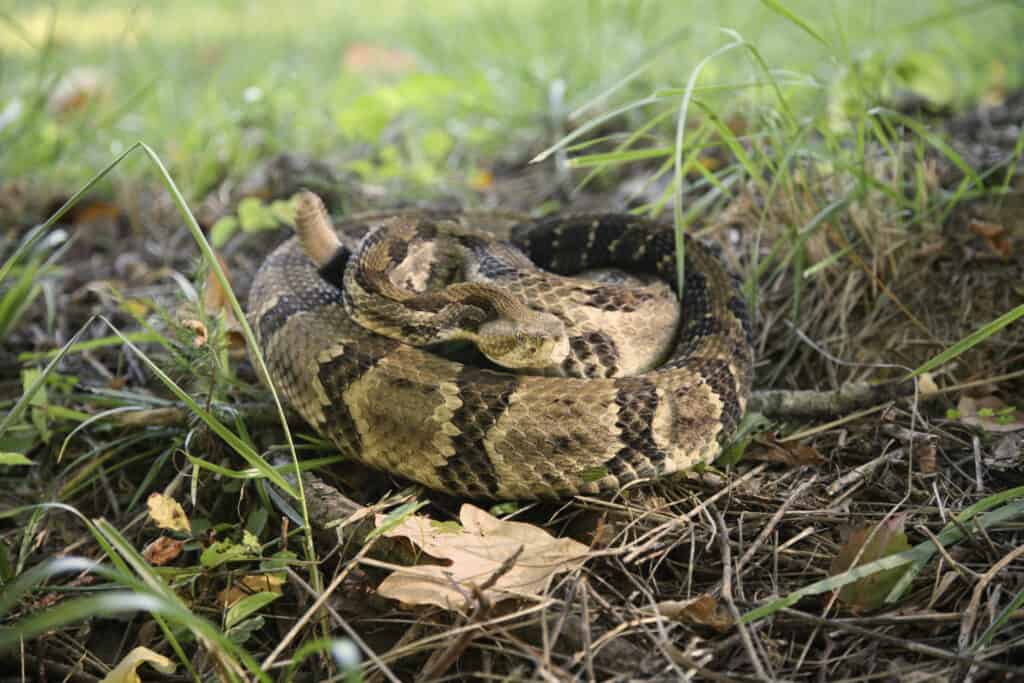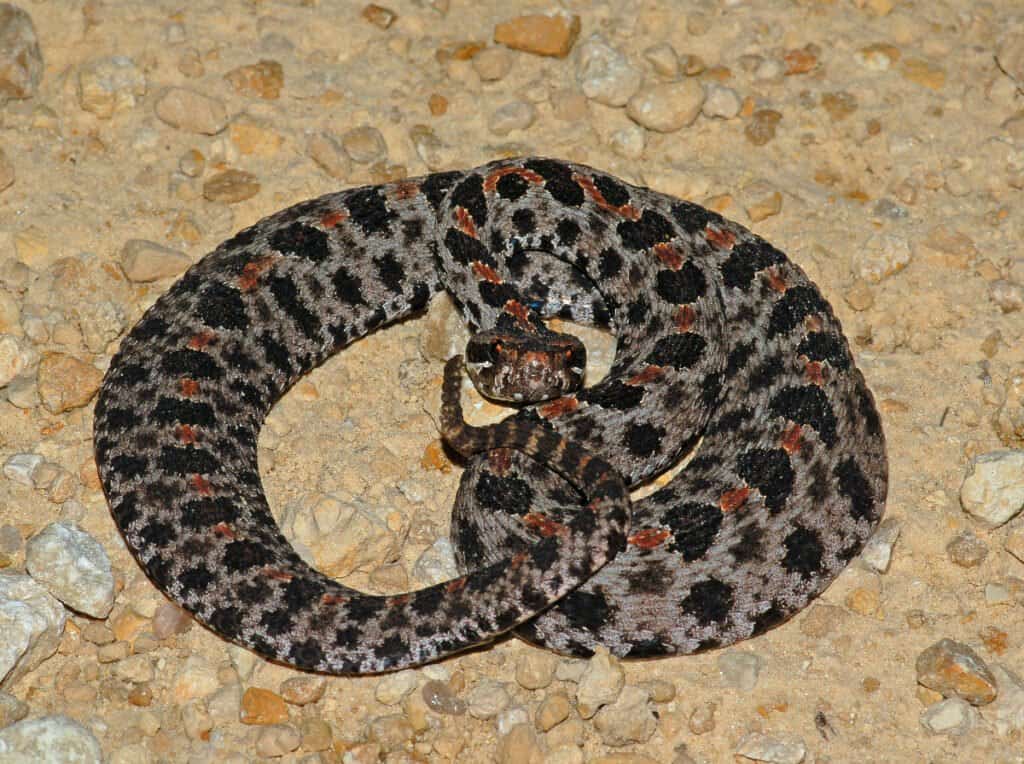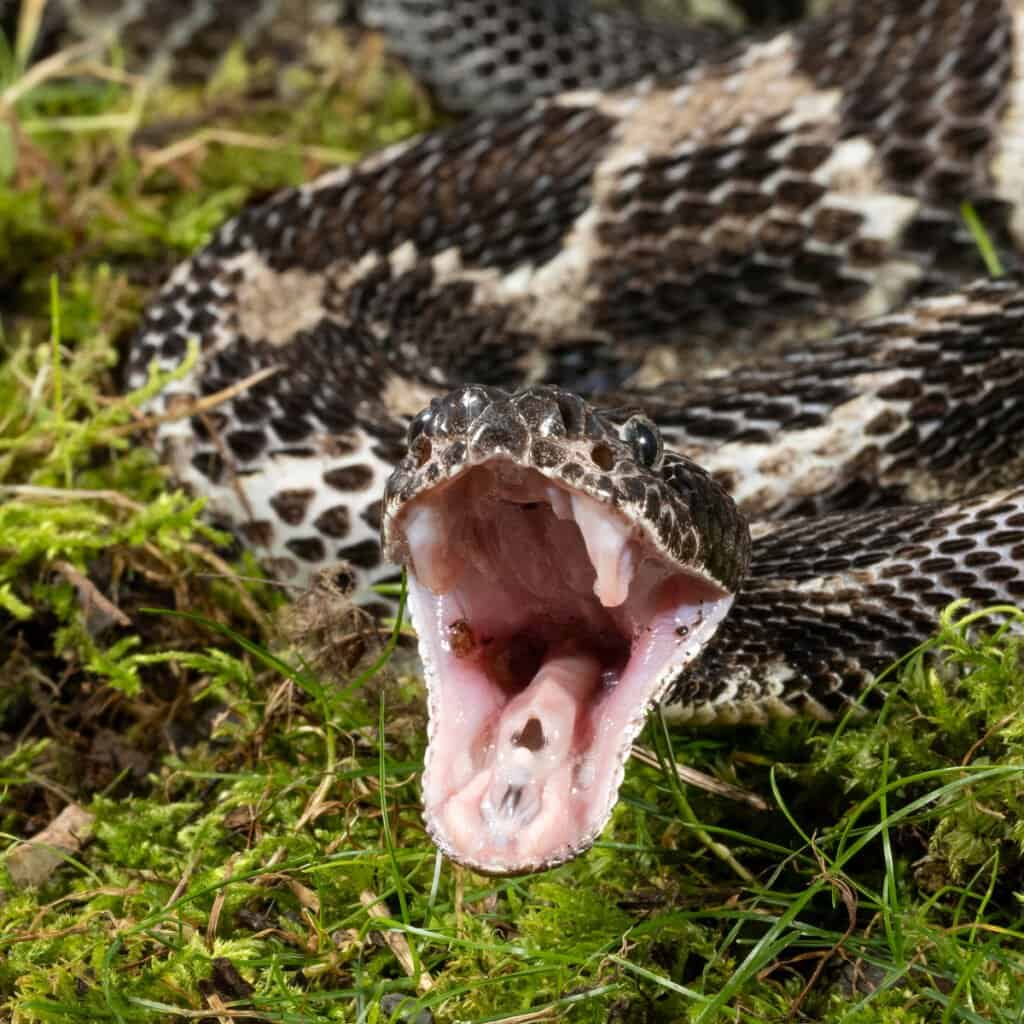Landlocked in the southeastern United States, the state of Tennessee has a wide variety of natural features and biodiversity. Hikers are drawn to the Blue Ridge Mountains and the Appalachia Mountains. Anglers enjoy the Tennessee and Mississippi Rivers, alongside the beautiful waterfalls and valleys of the Cumberland Plateau. Walking through its scenic deciduous forests may have you wondering what types of snakes also call this beautiful place home.
There are 32 different species of snakes in Tennessee, all of which play an important role in keeping rodent populations in check and balancing the state’s ecosystems. Only four of the 32 snake species in the state are venomous, only two of which are rattlesnakes. We’ll help you learn how to identify the two types of rattlesnakes in Tennessee. We cover where to find them and how to stay safe while enjoying your time exploring the outdoors.
1. Timber Rattlesnake

The timber rattlesnake is extremely venomous, but they are not typically aggressive.
©iStock.com/NajaShots
| Timber Rattlesnake | Information |
|---|---|
| Range | All of Tennessee |
| Length | 36-60 inches |
As the largest venomous snake in Tennessee, the timber rattlesnake is pretty easy to identify. This snake is the larger of the two types of rattlesnakes and can be found all across Tennessee. Timber rattlesnakes are most common on south-facing hillsides or rocky outcroppings near mature and densely wooded forests. They often bask in the sun on rocky bluffs or ledges in these areas. However, they also frequent cane thickets, rural habitats, mountains, swamps, and wooded stream corridors throughout the summer.
Appearance
Timber rattlesnakes are large and have heavy, thick bodies that grow between 36-60 inches long. The ones you’ll see in Tennessee are usually gray, but occasionally they may be dark brown, black, brown, pink, tan, or yellow as well. They have black zig-zag-shaped crossbands down their backs and a distinctly black tail, just before their iconic keratin rattle. Most timber rattlesnakes in Tennessee also have a rust-colored stripe down the middle of their spines as well.
Timber rattlesnakes are pit vipers, so their heads are broad and triangular-shaped to accommodate their large venom glands. They have vertical pupils almost like cat eyes. Heat-sensing “pits” sit between their eyes and nostrils, helping them to detect prey as well as predators. Their heads vary in color, from yellow to light tan or gray, with a dark stripe from each eye to the jaw. Their bellies are light gray or tan and are usually sprinkled with darker colored speckles.
Behavior
Using their unique heat-sensing pits, timber rattlesnakes can lie in wait for long periods of time until their prey gets close enough to strike. These large snakes mostly eat small rodents like chipmunks, rats, mice, and squirrels, although on occasion they will also hunt lizards, smaller snakes, and birds. They have very large fangs and can inject a great amount of venom into a single bite. This snake can have one of four venom types, but in Tennessee, the only confirmed venom is the hemotoxic type.
However, as is nature’s way, the dangerous venom and bite of a timber rattlesnake is balanced by its shy and nonaggressive nature. Unless it is completely cornered or being attacked or harassed, a timber rattlesnake will always try to flee from danger or hide using its camouflage coloring. When spotted, a timber rattlesnake will rattle its tail loudly for quite a while before ever attempting to strike. A timber rattlesnake only attacks as a last resort and does not always use all its venom at once. So, while it is of course a very dangerous snake that you should avoid, you can be sure that a timber rattlesnake will not go out of its way to do you harm.
2. Western Pygmy Rattlesnake

Pygmy rattlesnakes are fairly rare in Tennessee.
©Gerald A. DeBoer/Shutterstock.com
| Western Pygmy Rattlesnake | Information |
|---|---|
| Range | Along western Highland Rim from Stewart County to southern border of Tennessee |
| Length | 15-20 inches |
The smallest venomous snake in Tennessee is the western pygmy rattlesnake. It is not nearly as common as the timber rattlesnake, so not a lot of known about it in the state. Western pygmy rattlesnakes live from Stewart County along the western Highland Rim to the southern border of Tennessee, although the best place to see them is in the Land Between the Lakes, usually near water. Pygmy rattlesnakes are very rare in Tennessee and are protected by state laws as a Threatened species.
Sometimes referred to as “swamp rattlers,” pygmy rattlesnakes are great swimmers and prefer habitats that are close to water, like wetlands, moist fields, and flood plains. They can be seen in pine woods, glades, and rocky uplands on occasion as well. They are ambush hunters and eat lizards, amphibians, small snakes, and small rodents.
Appearance
Western pygmy rattlesnakes are also pit vipers, but they are much smaller than timber rattlesnakes, growing only 15-20 inches long. Their bodies are tan or gray, with dark oval or bar-shaped blotches that run down their backs and sides. Most pygmy rattlesnakes in Tennessee also have a rust or orange-brown stripe running along the middle of their spines as well. Their heads are broad with vertical pupils and heat-sensing pits, and a black stripe runs from each eye down to the corner of the snake’s mouth. Young pygmy rattlesnakes look a lot like adults, but the tips of their tails are yellow. Adult snakes have 6-8 dark rings at the end of their tails before their keratin rattle.
Behavior
Since pygmy rattlesnakes are so small, their rattle is not nearly as loud as a timber rattlesnake. In fact, if you are further than 3 feet away from one of these snakes, you likely will not hear their rattle at all! If you do hear a pygmy rattlesnake rattling, it will sound a lot like a buzzing insect. Like the timber rattlesnake, pygmy rattlesnakes are shy and secretive. They prefer to stay hidden and avoid humans whenever possible.
Staying Safe from Rattlesnakes in Tennessee

Rattlesnakes in Tennessee usually only strike as a last resort.
©Joe McDonald/Shutterstock.com
Since most rattlesnake bites occur when a hiker inadvertently steps on a snake, be sure to watch carefully where you step (or where you put your hands) when you are outside in Tennessee. If you go hiking, wear tall boots to protect your feet and legs from potential harm. If you see a snake, leave it alone! Do not try to move the snake, even to relocate it. If you leave a timber or pygmy rattlesnake alone, it will return the favor. If you want to explore the great outdoors with a canine companion, make sure to keep your dog from sniffing in piles of leaves or under rocky areas and boulders.
The photo featured at the top of this post is © Joe McDonald/Shutterstock.com
Discover the "Monster" Snake 5X Bigger than an Anaconda
Every day A-Z Animals sends out some of the most incredible facts in the world from our free newsletter. Want to discover the 10 most beautiful snakes in the world, a "snake island" where you're never more than 3 feet from danger, or a "monster" snake 5X larger than an anaconda? Then sign up right now and you'll start receiving our daily newsletter absolutely free.
Sources
- Tennessee State Gov, Available here: https://www.tn.gov/twra/wildlife/reptiles/snakes/timber-rattlesnake.html
- Tennessee State Gov, Available here: https://www.tn.gov/twra/wildlife/reptiles/snakes/pygmy-rattlesnake.html
Thank you for reading! Have some feedback for us? Contact the AZ Animals editorial team.






